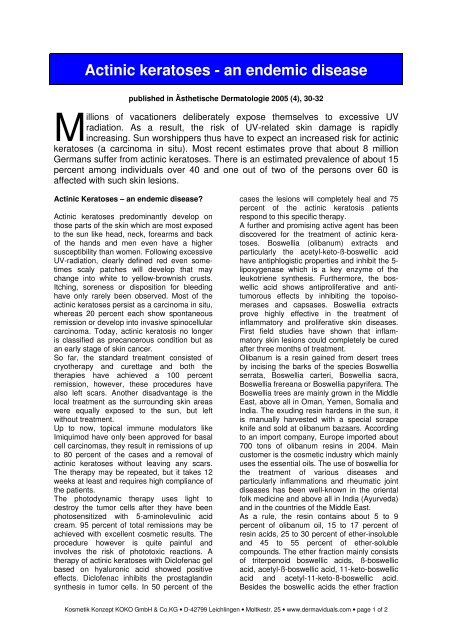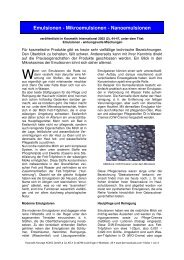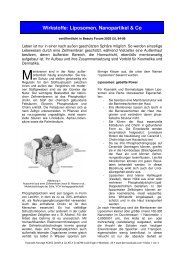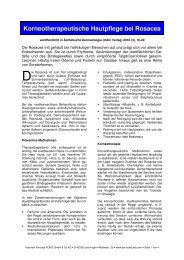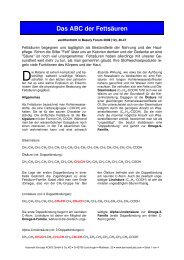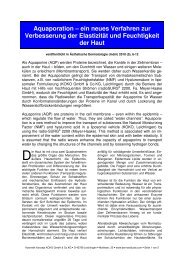Actinic keratoses - an endemic disease - Dermaviduals
Actinic keratoses - an endemic disease - Dermaviduals
Actinic keratoses - an endemic disease - Dermaviduals
You also want an ePaper? Increase the reach of your titles
YUMPU automatically turns print PDFs into web optimized ePapers that Google loves.
<strong>Actinic</strong> <strong>keratoses</strong> - <strong>an</strong> <strong>endemic</strong> <strong>disease</strong><br />
published in Ästhetische Dermatologie 2005 (4), 30-32<br />
M<br />
illions of vacationers deliberately expose themselves to excessive UV<br />
radiation. As a result, the risk of UV-related skin damage is rapidly<br />
increasing. Sun worshippers thus have to expect <strong>an</strong> increased risk for actinic<br />
<strong>keratoses</strong> (a carcinoma in situ). Most recent estimates prove that about 8 million<br />
Germ<strong>an</strong>s suffer from actinic <strong>keratoses</strong>. There is <strong>an</strong> estimated prevalence of about 15<br />
percent among individuals over 40 <strong>an</strong>d one out of two of the persons over 60 is<br />
affected with such skin lesions.<br />
<strong>Actinic</strong> Keratoses – <strong>an</strong> <strong>endemic</strong> <strong>disease</strong>?<br />
<strong>Actinic</strong> <strong>keratoses</strong> predomin<strong>an</strong>tly develop on<br />
those parts of the skin which are most exposed<br />
to the sun like head, neck, forearms <strong>an</strong>d back<br />
of the h<strong>an</strong>ds <strong>an</strong>d men even have a higher<br />
susceptibility th<strong>an</strong> women. Following excessive<br />
UV-radiation, clearly defined red even sometimes<br />
scaly patches will develop that may<br />
ch<strong>an</strong>ge into white to yellow-brownish crusts.<br />
Itching, soreness or disposition for bleeding<br />
have only rarely been observed. Most of the<br />
actinic <strong>keratoses</strong> persist as a carcinoma in situ,<br />
whereas 20 percent each show spont<strong>an</strong>eous<br />
remission or develop into invasive spinocellular<br />
carcinoma. Today, actinic keratosis no longer<br />
is classified as prec<strong>an</strong>cerous condition but as<br />
<strong>an</strong> early stage of skin c<strong>an</strong>cer.<br />
So far, the st<strong>an</strong>dard treatment consisted of<br />
cryotherapy <strong>an</strong>d curettage <strong>an</strong>d both the<br />
therapies have achieved a 100 percent<br />
remission, however, these procedures have<br />
also left scars. Another disadv<strong>an</strong>tage is the<br />
local treatment as the surrounding skin areas<br />
were equally exposed to the sun, but left<br />
without treatment.<br />
Up to now, topical immune modulators like<br />
Imiquimod have only been approved for basal<br />
cell carcinomas, they result in remissions of up<br />
to 80 percent of the cases <strong>an</strong>d a removal of<br />
actinic <strong>keratoses</strong> without leaving <strong>an</strong>y scars.<br />
The therapy may be repeated, but it takes 12<br />
weeks at least <strong>an</strong>d requires high compli<strong>an</strong>ce of<br />
the patients.<br />
The photodynamic therapy uses light to<br />
destroy the tumor cells after they have been<br />
photosensitized with 5-aminolevulinic acid<br />
cream. 95 percent of total remissions may be<br />
achieved with excellent cosmetic results. The<br />
procedure however is quite painful <strong>an</strong>d<br />
involves the risk of phototoxic reactions. A<br />
therapy of actinic <strong>keratoses</strong> with Diclofenac gel<br />
based on hyaluronic acid showed positive<br />
effects. Diclofenac inhibits the prostagl<strong>an</strong>din<br />
synthesis in tumor cells. In 50 percent of the<br />
cases the lesions will completely heal <strong>an</strong>d 75<br />
percent of the actinic keratosis patients<br />
respond to this specific therapy.<br />
A further <strong>an</strong>d promising active agent has been<br />
discovered for the treatment of actinic <strong>keratoses</strong>.<br />
Boswellia (olib<strong>an</strong>um) extracts <strong>an</strong>d<br />
particularly the acetyl-keto-ß-boswellic acid<br />
have <strong>an</strong>tiphlogistic properties <strong>an</strong>d inhibit the 5lipoxygenase<br />
which is a key enzyme of the<br />
leukotriene synthesis. Furthermore, the boswellic<br />
acid shows <strong>an</strong>tiproliferative <strong>an</strong>d <strong>an</strong>titumorous<br />
effects by inhibiting the topoisomerases<br />
<strong>an</strong>d capsases. Boswellia extracts<br />
prove highly effective in the treatment of<br />
inflammatory <strong>an</strong>d proliferative skin <strong>disease</strong>s.<br />
First field studies have shown that inflammatory<br />
skin lesions could completely be cured<br />
after three months of treatment.<br />
Olib<strong>an</strong>um is a resin gained from desert trees<br />
by incising the barks of the species Boswellia<br />
serrata, Boswellia carteri, Boswellia sacra,<br />
Boswellia frere<strong>an</strong>a or Boswellia papyrifera. The<br />
Boswellia trees are mainly grown in the Middle<br />
East, above all in Om<strong>an</strong>, Yemen, Somalia <strong>an</strong>d<br />
India. The exuding resin hardens in the sun, it<br />
is m<strong>an</strong>ually harvested with a special scrape<br />
knife <strong>an</strong>d sold at olib<strong>an</strong>um bazaars. According<br />
to <strong>an</strong> import comp<strong>an</strong>y, Europe imported about<br />
700 tons of olib<strong>an</strong>um resins in 2004. Main<br />
customer is the cosmetic industry which mainly<br />
uses the essential oils. The use of boswellia for<br />
the treatment of various <strong>disease</strong>s <strong>an</strong>d<br />
particularly inflammations <strong>an</strong>d rheumatic joint<br />
<strong>disease</strong>s has been well-known in the oriental<br />
folk medicine <strong>an</strong>d above all in India (Ayurveda)<br />
<strong>an</strong>d in the countries of the Middle East.<br />
As a rule, the resin contains about 5 to 9<br />
percent of olib<strong>an</strong>um oil, 15 to 17 percent of<br />
resin acids, 25 to 30 percent of ether-insoluble<br />
<strong>an</strong>d 45 to 55 percent of ether-soluble<br />
compounds. The ether fraction mainly consists<br />
of triterpenoid boswellic acids, ß-boswellic<br />
acid, acetyl-ß-boswellic acid, 11-keto-boswellic<br />
acid <strong>an</strong>d acetyl-11-keto-ß-boswellic acid.<br />
Besides the boswellic acids the ether fraction<br />
Kosmetik Konzept KOKO GmbH & Co.KG • D-42799 Leichlingen • Moltkestr. 25 • www.dermaviduals.com • page 1 of 2
<strong>Actinic</strong> <strong>keratoses</strong> - <strong>an</strong> <strong>endemic</strong> <strong>disease</strong>? page 2 of 2<br />
contains essential oils <strong>an</strong>d saccharides such<br />
as galactose, arabinose, m<strong>an</strong>nose <strong>an</strong>d xylose.<br />
According to the current state of knowledge,<br />
the boswellic acids are the pharmacological<br />
effective agents among the components of the<br />
above mentioned olib<strong>an</strong>um resins. Sashwati et<br />
al. (cf DNA <strong>an</strong>d Cell Biology 24 (4), 244-255,<br />
2005) detected the <strong>an</strong>ti-inflammatory <strong>an</strong>d<br />
collagen protecting mech<strong>an</strong>ism of the boswellic<br />
acid. Furthermore, a signal cascade was<br />
identified where acetyl-keto-boswellic acid<br />
inhibits the expression of matrix metalloproteinases<br />
(MMP), i.e. enzymes which selectively<br />
destroy peptid bonds <strong>an</strong>d structural proteins<br />
like collagen <strong>an</strong>d connective tissue.<br />
Acetyl-keto-boswellic acid signific<strong>an</strong>tly inhibits<br />
the expression of VCAM <strong>an</strong>d ICAM, the adhesion<br />
molecules which participate in infiltrating<br />
white blood cells into the inflamed area.<br />
The org<strong>an</strong>ism copes with tissue damages by<br />
provoking inflammatory reactions as a me<strong>an</strong>s<br />
to remove the damaging foreign bodies or the<br />
damaged tissue parts <strong>an</strong>d to replace them by<br />
repair tissue. Hence, inflammations are<br />
physiological processes. There are however<br />
situations where inflammatory processes may<br />
considerably damage org<strong>an</strong> functions, <strong>an</strong>d in<br />
this specific case, the skin functions. Inflammations<br />
are biochemically started by the<br />
release of so-called inflammation mediators.<br />
There are two types of different inflammation<br />
mediators which are involved in initiating <strong>an</strong>d<br />
maintaining inflammatory processes, viz.<br />
prostagl<strong>an</strong>dins <strong>an</strong>d leukotrienes. The current<br />
therapy of inflammatory processes consists of<br />
medicinal drugs which are able to block the socalled<br />
arachidonic acid cascade, i.e. the<br />
specific part which contributes to the formation<br />
of prostagl<strong>an</strong>dins. The drugs used are part of<br />
the steroid <strong>an</strong>d non-steroid <strong>an</strong>tiphlogistics.<br />
Based on this mech<strong>an</strong>ism also is the use of<br />
Diclofenac for the treatment of actinic keratosis.<br />
The <strong>an</strong>ti-inflammatory effect of the boswellic<br />
acids was repeatedly published (Safayhi, H., et<br />
al., Pl<strong>an</strong>ta Medica 63, 487-493, 1997, J.<br />
Pharmacol <strong>an</strong>d Exp. Ther., 261, 1163-46,<br />
1992). By screening the hum<strong>an</strong> genome,<br />
Sashwati et al. <strong>an</strong>alysed the genetic base of<br />
the <strong>an</strong>tiphlogistic effect of boswellia in<br />
microvascular endothelial cells <strong>an</strong>d discovered<br />
that it inhibits the 5-lipoxygenase, which is a<br />
key enzyme for the biosynthesis of<br />
leukotrienes. The studies showed that 3-Oacetyl-11-keto-ß-boswellic<br />
acid proved to be<br />
the most effective 5-lipoxygenase inhibitor<br />
among the different boswellic acids.<br />
Furthermore, the boswellic acids prevented the<br />
TNF-alpha-induced expression of metalloproteinases<br />
<strong>an</strong>d of apoptosis mediators.<br />
Boswellia extracts also prevented the<br />
expression of VCAM-1 <strong>an</strong>d ICAM-1. The<br />
results of these studies showed that the <strong>an</strong>tiinflammatory<br />
effects of boswellia extracts<br />
consisted in influencing the signalling<br />
mech<strong>an</strong>ism of the inflammation. Additionally,<br />
boswellic acids have cytostatic effects which<br />
are based on the inhibition of topoisomerases<br />
as reported in Syrovets et al., Mol. Pharmacol,<br />
58, 71-81, 2000. It could also be demonstrated<br />
that boswellic acids spark off apoptoses (cf<br />
Shao et al., Pl<strong>an</strong>ta Medica 64, 328-331, 1998).<br />
The effects mentioned suggest boswellic acids<br />
as <strong>an</strong> appropriate drug for the treatment of<br />
tumors as Ammon <strong>an</strong>d Simmet have shown<br />
with their therapy of brain tumors. Only<br />
recently there have been reports on the<br />
chemopreventive <strong>an</strong>d therapeutic effects of<br />
acetyl-keto-boswellic acids in the treatment of<br />
different types of c<strong>an</strong>cer (cf Glaser T, et al., Br<br />
J C<strong>an</strong>cer 80: 756-765, 1999; J<strong>an</strong>ssen G et al.,<br />
Klin Pädiatr 212: 189-195, 2000; Winking M et<br />
al.: J Neurooncol 46: 97-103, 2000). In this<br />
connection, the boswellic acid-induced<br />
inhibition of the topoisomerase-1 <strong>an</strong>d -2 <strong>an</strong>d of<br />
the caspase-8 seems to play a signific<strong>an</strong>t role<br />
(cf Ji<strong>an</strong>-Jun Liu et al., Intern J of Molecular<br />
Medicine 10: 501-505, 2002).<br />
According to the current state of knowledge,<br />
the treatment of inflammatory <strong>an</strong>d malign<strong>an</strong>t<br />
skin <strong>disease</strong>s with boswellia extracts or with<br />
isolated boswellic acids <strong>an</strong>d their derivatives<br />
has not yet been mentioned in the international<br />
scientific literature.<br />
For the treatment of actinic <strong>keratoses</strong>, a<br />
st<strong>an</strong>dardised boswellia extract containing at<br />
least 30 percent of acetyl-keto-boswellic acid<br />
has been isolated <strong>an</strong>d embedded in<br />
n<strong>an</strong>oparticles. This active concentrate has<br />
been very well tolerated on the skin, it is nongreasing<br />
<strong>an</strong>d free of the excessively adhesive<br />
properties of the raw extract. The boswellia<br />
concentrate was blended into a DMS cream<br />
(Derma Membr<strong>an</strong>e Structure), (KOKO, Leichlingen)<br />
<strong>an</strong>d used for the treatment of actinic<br />
<strong>keratoses</strong> <strong>an</strong>d psoriasis lesions. Additionally,<br />
the boswellia extract was added to a vegetable<br />
oil mixture <strong>an</strong>d used as a pack for the<br />
treatment of the scalp.<br />
First pilot applications have proved that<br />
inflammatory <strong>an</strong>d proliferative skin <strong>disease</strong>s<br />
healed relatively fast with the above mentioned<br />
therapy. These primary results seem to<br />
present boswellia extracts as a promising<br />
therapy against inflammatory <strong>an</strong>d malign<strong>an</strong>t<br />
skin <strong>disease</strong>s. Further field studies regarding<br />
psoriasis <strong>an</strong>d spinocellular carcinoma cases<br />
but also inflammatory skin <strong>disease</strong>s like<br />
neurodermatitis <strong>an</strong>d acne have been<br />
scheduled.<br />
Dr. H. Jabs<br />
Kosmetik Konzept KOKO GmbH & Co.KG • D-42799 Leichlingen • Moltkestr. 25 • www.dermaviduals.com • page 2 of 2


